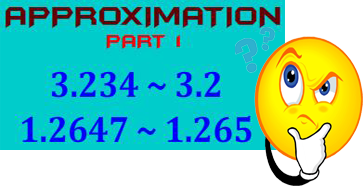| Home » Articles » LESSON NOTES (Mathematics) » Upper Primary |
|
APPROXIMATIONS
ROUNDING OFF NUMBERS This is the procedure for approximation of any number so that it can be evaluated or read easy. For example you can be given a number with many decimals like 2.564879 or 12.789007 these are very complicated numbers, so in order to make them simple without changing their values approximation is introduced in so that we can read them and evaluate easily. From the given numbers above can be approximated to one decimal place as 2.6 and 12.8. But note that when you approximate any number it is not wrong but the number loose a little accuracy for example when given 5.6421 and round to one decimal place so that it becomes 5.6 and to two decimal places becomes 5.64, 5.64 is more accurate than 5.6
DECIMAL APPROXIMATION. Any decimal number has two parts that are decimal part and the part containing whole number for example if you are given number 2.65, here 65 is in decimal part and 2 is in the part of whole number. So, we need to know the decimal places, what are these? Decimal places are place of numbers in decimal part. For example 2.65 has two decimal places because there are two digits in decimal part. To obtain the decimal places you just count the digits in decimal part. Lets see the following:-
1.567 has 3 decimal places. 12.4498 has 4 decimal places 809.166887 has 6 decimal places 655 has no decimal place
How to approximate: Example 1 Approximate 2.654 to one decimal place. Solution 2.674 has 3 decimal places but we are required to round it off to one decimal place so that our answer should have one decimal place, now lets see how we can round off to the required decimal places:
4. Lastly our answer now is 2.7 ( to one D.P as Instructed)
NOTE: Do not change the numbers in the whole part because we only deal with decimal part.
Example 2 Approximate 14.9542 to 3 decimal places.
Solution 14.9542 has 4 decimal places but we are required to round it off to 3 decimal places so that our answer should have 3 decimal places now lets continue to rules of rounding off decimal places
Other examples:
6.4878 to one decimal place = 6.5 (Refer to the example 1 above) 765.1256 to two decimal places = 765.13 (Refer to the example 1 above) 54.26779442 to six decimal places = 54. 267794 (Refer to the example 2 above) 2.7189 to one decimal place = 2.7 (Refer to the example 2 above)
The next tutorial will deal with Whole numbers and significant figures.
Wish you all the best, Click here for next tutorial.
*********************************
© Yahyou M. (Math's Tutor)
| |
| Views: 3589 | |
| Total comments: 0 | |








